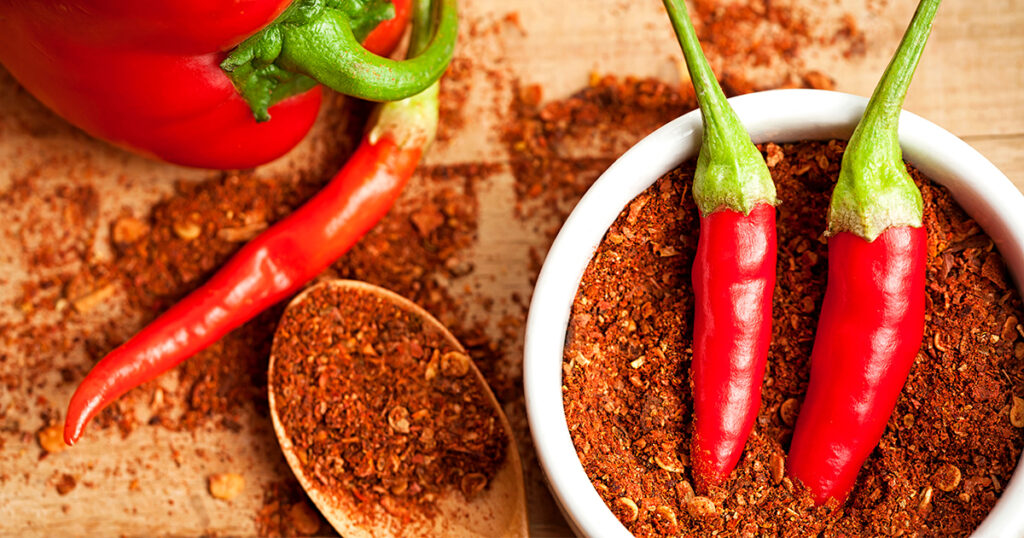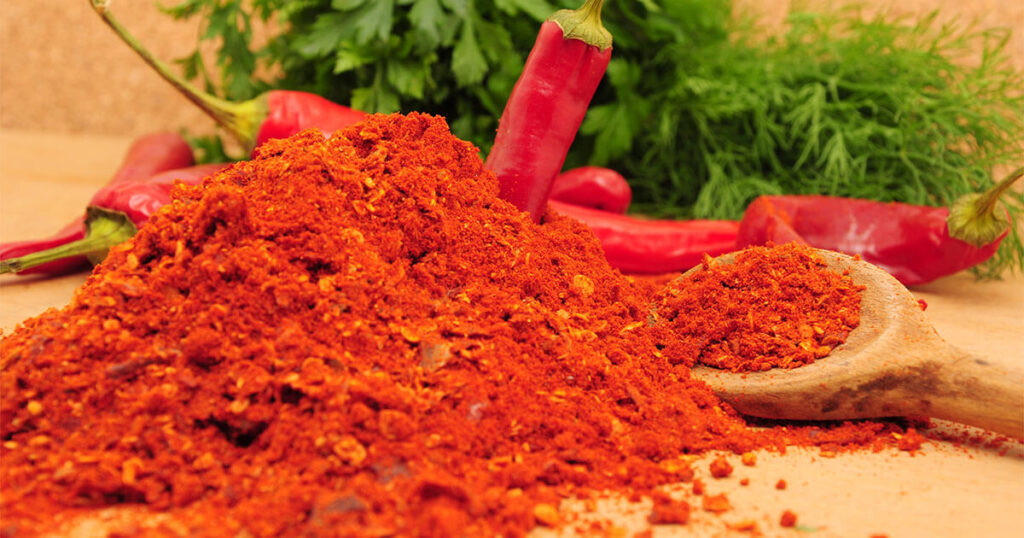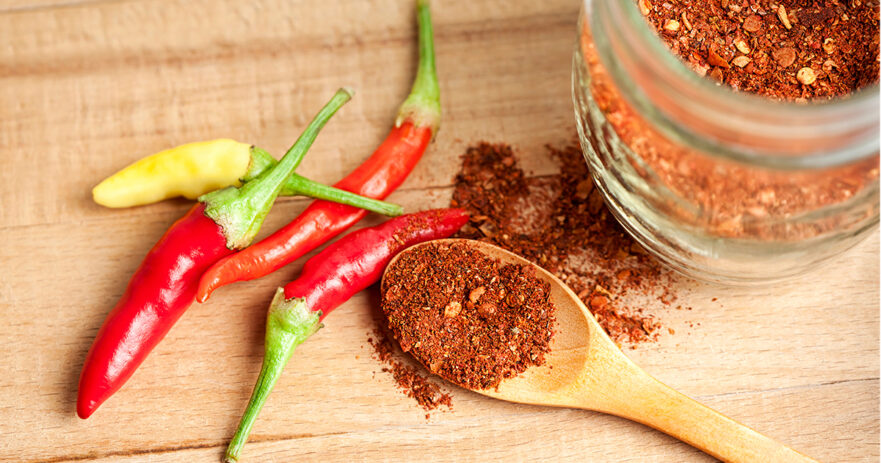Cayenne pepper is a type of annual herb belonging to the Solanaceae family, known for its glossy red peppers that are narrow, twisted, and taper to a thin, curled tip. The name “Cayenne” is derived from the city of Cayenne in French Guiana, South America. It is widely recognized for its culinary uses, particularly as a spice to add flavor and heat to various dishes [1].
With its vibrant red hue and intense flavor, Cayenne pepper is more than just a culinary delight.
It’s a natural source of fiber, calcium, magnesium, phosphorus, potassium, Vitamin C, Vitamin A, Vitamin K, and folate, offering a spicy twist to your skin’s health journey [2].
In this article, we’ll delve into the science behind how this fiery spice can elevate your skincare regimen, uncover the remarkable benefits it brings to your skin, and even share a DIY cayenne pepper face mask recipe to pamper your skin. Get ready to spice up your skincare routine with cayenne pepper!
Key Takeaways
- Due to its constituents, including essential vitamins, particularly vitamin C, Cayenne pepper may help improve the skin barrier, reduce inflammation, and address skin conditions [3][4].
- Applying a DIY cayenne pepper face mask could support collagen, reducing wrinkles [5][6].
- Cayenne pepper’s anti-inflammatory properties can help combat acne, reducing inflammation and promoting clearer skin [9].
Cayenne Pepper Benefits for Skin
Atopic Dermatitis
In the world of cayenne pepper, there’s more than just a spicy zing — it’s also packing some vitamin C power, with 100 grams containing a hefty 76.4 milligrams of this essential nutrient [2]. Let’s talk about atopic dermatitis (AD), a pesky skin inflammation often tied to allergies. AD brings along those annoying red bumps, itching, and scaling.
But here’s where cayenne’s vitamin C enters the picture – it plays a role in maintaining our skin barrier. You see, our skin relies on things like keratinocytes and their intercellular lipids to stay sturdy, and vitamin C steps up the game by promoting keratinocyte differentiation and the production of vital skin material [3].
People dealing with AD often find themselves short on nutrients, including vitamin A and, you guessed it, vitamin C. But research suggests that upping your vitamin C intake can be a game-changer. Some studies show that a diet rich in vitamin C may help ease chronic inflammation and potentially improve AD symptoms [3].
Vitamin C doesn’t stop there; it also lends a hand in boosting ceramide production in keratinocytes, which is a fancy way of saying it helps strengthen the outer layer of your skin [3]. So, while it might not be a magical cure, vitamin C in cayenne pepper can be a helpful addition to your skincare arsenal when dealing with skin issues like AD.

Psoriasis
Psoriasis, a persistent and often discomforting skin condition, arises from an overactive immune system, triggering the rapid multiplication of skin cells. This unruly behavior results in scaly and inflamed patches, most frequently found on the scalp, elbows, or knees, though it can appear elsewhere on the body [9].
Now, here’s where Cayenne pepper steps into the picture. Its primary active component, capsaicin, serves as the main active ingredient [4].
Research suggests that applying capsaicin topically can improve psoriasis symptoms, demonstrating superiority over the vehicle in reducing scaling, infiltration, erythema, and pruritus. In studies, those who used capsaicin experienced a notable reduction in scaling and erythema – the redness of the skin.
Sure, there’s a catch – during initial applications, some reported a sensation of burning, stinging, itching, and reddening of the skin. But here’s the twist: these discomforts diminished or vanished entirely with continued use.
Capsaicin creams have become a go-to option for people living with psoriasis, effectively alleviating itching and inflammation [10].
However, caution is warranted, as capsaicin should not be applied to open wounds and is unsuitable for facial use [11]. But, when it comes to those persistent psoriasis patches, cayenne pepper’s capsaicin might just be the spicy solution you’ve been looking for.
Acne
When battling acne, cayenne pepper might not be the first thing that comes to mind, but it has some remarkable benefits worth exploring. Acne is a persistent and pesky skin issue. This unwelcome condition is driven by many factors, including overactive sebaceous glands, clogged pores, hormonal imbalances, inflammation, and bacterial intruders [12].
However, Cayenne pepper can help. It’s been in the spotlight for its remarkable anti-inflammatory properties. In simpler terms, vitamin C has a special power – it stops something called NFkB, which is like a switch that turns on inflammation in our skin.
When this switch is on, our skin produces things that cause redness and pimples, like TNF-alfa, IL1, IL6, and IL8. So, using cayenne pepper (which has vitamin C) can help calm down this inflammation in your skin.
That’s why it can be useful for conditions like acne vulgaris and rosacea [9]. So, while you savor the fiery flavors of cayenne in your dishes, remember it’s not just pleasing your palate—it might also contribute to clearer, healthier skin.
Collagen Production
As we journey through life, our skin faces many challenges, including the inevitable effects of aging, which can leave its mark in the form of reduced elasticity and the formation of wrinkles. All skin layers undergo structural changes with age, making them more vulnerable to various skin disorders and conditions [6].
As we advance in years, we start to see signs of aging, both from our body’s natural processes (intrinsic aging) and things in our environment like sunlight and smoking (extrinsic aging).
These signs include skin becoming paler, losing its elasticity, and sometimes getting those lines we call expression lines. Under the surface, the dermal layer thins, and there are fewer fibroblasts and mast cells, resulting in decreased collagen production and reduced vascularization.
The vitamin A and vitamin C in the Cayenne pepper step into the spotlight here, offering possible protection against these age-related changes and aiding in skin regeneration [21][6]. Cayenne pepper, owing to its vitamin contents, may play a role in collagen production, the key to maintaining skin firmness and resilience [5][21][22].
Vitamin C is a cofactor for enzymes that strengthen collagen fibers and directly activates the genes responsible for collagen synthesis.
Additionally, it helps stabilize the messenger RNA that regulates collagen production while increasing the expression of collagen-related genes and reducing collagen degradation [5]. So, it is helping you put your best face forward.
Dry Skin
Dry skin is a familiar annoyance for many of us, triggered by various factors such as skincare routines, health issues, medications, and environmental shifts in temperature, humidity, and airflow. It’s worth noting that the likelihood of experiencing dry skin increases as we age.
Initially, this was attributed to decreased water content and sebum production in the skin; however, recent insights suggest a more intricate process involving alterations in keratinization and lipid composition in the outermost layer of our skin, the stratum corneum [6].
Often celebrated for its culinary zest, Cayenne pepper may have a surprising role in addressing dry skin—the secret lies in its vitamin C content, a powerful contributor to skin health. Vitamin C can boost the production of crucial skin barrier lipids, particularly ceramides, which make up a significant portion of the stratum corneum’s intercellular lipids.
These lipids are vital in preserving skin moisture and preventing water loss. Additionally, it helps stimulate the differentiation of keratinocytes, essential for forming the stratum corneum, further enhancing the skin’s ability to shield itself against dehydration [6].
Moreover, Cayenne pepper’s unique ability to increase blood circulation and draw it to specific areas makes it a valuable addition to your skincare routine. As a counterirritant, it brings blood to the surface, helping to remove toxins and promote improved blood circulation, which can be beneficial in addressing dry skin concerns [23].
Wrinkles
Wrinkles, those signs of the passage of time on our skin, can result from natural aging and external factors like sun exposure and smoking. These fine lines and creases often form in the deeper dermal layer, where changes occur, but the precise molecular mechanisms are still a mystery.
Researchers suspect that the loss of collagen, damage to collagen and elastic fibers, and alterations in the dermal-epidermal junction may all play a part.
One intriguing theory suggests that UV light can trigger the production of cytokines, leading to the expression of fibroblast elastase, which then breaks down elastic fibers, causing a loss of skin elasticity and the formation of wrinkles [6].
But cayenne pepper may offer a surprising benefit for those battling wrinkles. Once again, it’s Vitamin C content to the rescue. When applied topically, vitamin C has shown promise in reducing the appearance of wrinkles.
Still, its effectiveness might depend on an individual’s vitamin C status. Studies have found that improved vitamin C levels could potentially protect against wrinkle formation by enhancing collagen synthesis [6]. If considering a cayenne-based topical treatment, dilution with oil is paramount to prevent skin irritation [23].
Additionally, while vitamin C’s protective role in skin health is established, the specific benefits of consuming vitamin C-rich foods like cayenne pepper in wrinkle prevention warrant further exploration [24].
DIY Cayenne Pepper Face Mask Recipe
Ingredients
- 1/2 teaspoon of cayenne pepper powder
- 2 tablespoons of honey
- 1 tablespoon of plain yogurt
- 1 teaspoon of olive oil (optional)
Preparation
Before you begin, ensure that you have all your ingredients ready and find a comfortable workspace. Pulling your hair back is a good idea to prevent any contact with the mask during application.
Mixing
- In a small mixing bowl, combine 1/2 teaspoon of cayenne pepper powder, 2 tablespoons of honey, 1 tablespoon of plain yogurt, and, if you have dry skin, 1 teaspoon of olive oil (which is optional).
- Thoroughly mix all the ingredients until you achieve a smooth and consistent paste.
Patch Test
Before applying the mask to your face, it’s crucial to perform a patch test to ensure your skin doesn’t react adversely. Here’s how:
- Dab a small amount of the mixture on your wrist or the inside of your elbow.
- Wait a few minutes to observe any reactions, such as excessive burning or irritation. If you experience discomfort, remove the mixture immediately and wash the area with soap.
Application
If the patch test goes well, you can apply the mask to your face.
- Use a clean makeup brush or your fingers to gently and evenly apply the mixture, taking extra care to avoid the sensitive eye area.
Caution should be exercised when applying the DIY cayenne pepper face mask to prevent contact with the eyes and mucous membranes, as cayenne pepper can cause irritation! Do not use this mask too frequently!
Relax
Once the mask is evenly applied, take some time to relax for about 10-15 minutes. You may feel a warm, tingling sensation on your skin, which is entirely normal due to the cayenne pepper.
Rinse Off
After the designated time has passed, it’s time to wash off the mask.
- Use lukewarm water to gently rinse off the mask, being careful to be gentle while removing it and making sure that it does not come into contact with your eyes.
Moisturize
Finish the process by applying your favorite moisturizer to soothe your skin and lock in moisture, leaving your skin feeling refreshed and revitalized.
Health Benefits

⚕️Cayenne Pepper Powder
While primarily known for its spicy flavor, Cayenne pepper has been explored in some studies for its potential role in promoting skin health. These studies indicate that it might have the potential to provide a degree of protection against conditions such as psoriasis, atopic dermatitis, acne, dry skin, and wrinkles [3][6][8][10].
Additionally, cayenne pepper may support collagen formation, an essential element for maintaining the skin’s firmness and resilience, because of its C-vitamin content [5].
⚕️Honey
Honey, a natural marvel, possesses remarkable healing properties for the skin. It’s not just a sweetener; its antimicrobial abilities aid wound healing and tissue repair [13]. When applied topically, honey acts as a protective barrier, keeping the skin moist and aiding in wound healing [14].
This golden elixir also helps maintain youthful skin, delaying the onset of wrinkles, and guards against infections due to its antioxidant qualities [16].
⚕️Plain Yogurt
Rich in calcium, vitamins, and essential fatty acids, yogurt is a nutrition powerhouse [15]. Beyond its nutritional value, yogurt supports gut health, influencing skin health through the gut-skin axis [18]. The probiotics present in yogurt, especially Lactobacilli, can inhibit the growth of harmful yeast, promoting skin health [18].
⚕️Olive Oil
Olive oil, a treasure trove of over 30 phenolic compounds, showcases immense potential for skin health. It holds regenerative, anti-inflammatory, and antimicrobial properties, making it possible and beneficial in managing various skin conditions like psoriasis, atopic dermatitis, and actinic keratosis. The antioxidants and other phenolic compounds present, such as hydroxytyrosol and oleocanthal, contribute to the skin’s overall health [19].
Combining the forces of cayenne pepper, honey, plain yogurt, and olive oil in a DIY face mask can harness these potent natural ingredients to nurture and revitalize your skin, promoting a radiant and youthful complexion.
Summary
Cayenne pepper offers surprising benefits for your skin. Packed with vitamins and capsaicin, it may help tackle skin issues like atopic dermatitis and psoriasis by supporting the skin barrier and reducing inflammation.
It also combats Streptococcus pyogens, and its vitamin C content may promote collagen production, reducing wrinkles. Cayenne even addresses dry skin by boosting ceramide production.
Create a DIY Cayenne Pepper Face Mask using cayenne pepper powder, honey, plain yogurt, and olive oil to spice up your skincare routine. These natural ingredients work together to rejuvenate your skin, leaving it refreshed and revitalized.
FAQ
Does cayenne pepper help with wrinkles?
Cayenne pepper may assist with wrinkles as its vitamin C content encourages collagen production, a protein crucial for skin's elasticity and smoothness. This natural process, supported by cayenne pepper, may help reduce the visibility of wrinkles over time [6].
Does cayenne pepper help with acne?
Yes, cayenne pepper may help with acne. Cayenne pepper possesses antimicrobial properties that can be beneficial for acne. Additionally, Cayenne pepper has potential anti-inflammatory activity, which can be useful for managing conditions like acne vulgaris [7][9].
Is cayenne pepper anti-aging?
Yes, vitamins A and C in cayenne pepper may support collagen production and skin health, potentially offering anti-aging benefits. Collagen is essential for maintaining skin elasticity and preventing wrinkle formation. Additionally, the vitamin contents in cayenne pepper may promote skin health by reducing inflammation and irritation. Therefore, incorporating cayenne pepper into your skincare routine could contribute to anti-aging effects [5][6].
Does cayenne pepper make your skin glow?
Yes, cayenne pepper can contribute to skin radiance indirectly. Cayenne pepper has potent antioxidants that combat oxidative stress caused by environmental factors like UV radiation and pollution. By neutralizing free radicals, cayenne pepper helps protect the skin from damage, which can lead to a more glowing complexion when used as part of a skincare routine [5].
What happens when you take cayenne pepper every day?
When taken every day, cayenne pepper, rich in capsaicin, offers potential benefits for skin health. However, it's essential to exercise moderation. Possible side effects of excessive consumption include local skin reactions like redness, pain, and itching, as well as rare complications like dizziness and headaches [20]. Moreover, symptoms caused by ingesting too much capsaicin also include severe burning mouth sensation, mouth pain, itchiness, vomiting, nausea, and diarrhea [25]. Enjoy its benefits, but use it in moderation for a balanced approach to wellness.


Comments 1
This post was so very helpful and the cayenne pepper mask felt so very very good.
I was wondering how often I can out the mask on my face. I’m 70 years old
Thankyou